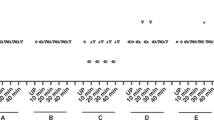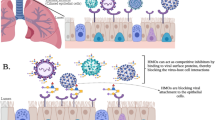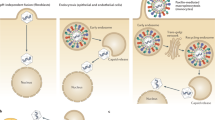Abstract
Background
The antiviral role of glycosaminoglycans in human milk (HM-GAGs) has been poorly investigated. They are highly sulfated polysaccharides, which were proposed to act as decoy receptors according to their structure. The aim of this study is to evaluate the antiviral potential and the mechanism of action of total and individual HM-GAGs against three pediatric clinically relevant viruses: respiratory syncytial virus (RSV), cytomegalovirus (HCMV), and rotavirus.
Methods
HM-GAGs were isolated from HM and a library of individual GAGs, structurally related to HM-GAGs, was prepared. The antiviral activity of HM-GAGs and the impact of thermal treatment were investigated in vitro by specific antiviral assays.
Results
We demonstrated that HM-GAGs are endowed with anti-HCMV and anti-RSV activity and that they act by altering virus attachment to cell. We clarified the contribution of individual HM-GAGs, showing a specific structure-related activity. We did not observe any alteration of HM-GAG antiviral activity after thermal treatment.
Conclusions
We showed that HM-GAGs contribute to the overall antiviral activity of HM, likely exerting a synergic action with other HM antiviral agents. HM-GAGs can now be added to the list of endogenous factors that may reduce breast-milk-acquired HCMV symptomatic infections and protecting infants from respiratory tract infections by RSV.
Impact
-
HM-GAGs have been poorly investigated for their antiviral action so far.
-
We demonstrated that HM-GAGs are endowed with significant anti-HCMV and anti-RSV activity and that they are able to alter virus binding to the cell.
-
The contribution of individual HM-GAGs is mainly exerted by the FMHep and is not based on a simple charge interaction between the virus and sulfate groups but involves a specific GAG structural configuration.
-
Our results contribute to identifying the multiple factors synergically acting in mediating HM antiviral properties and to clarifying their specific mechanism of action.
Similar content being viewed by others
Log in or create a free account to read this content
Gain free access to this article, as well as selected content from this journal and more on nature.com
or
Data availability
All data generated or analyzed during this study are included in this published article.
References
Andreas, N. J., Kampmann, B. & Mehring Le-Doare, K. Human breast milk: a review on its composition and bioactivity. Early Hum. Dev. 91, 629–635 (2015).
Ballard, O. & Morrow, A. L. Human milk composition: nutrients and bioactive factors. Pediatr. Clin. North Am. 60, 49–74 (2013).
Eriksen, K. G., Christensen, S. H., Lind, M. V. & Michaelsen, K. F. Human milk composition and infant growth. Curr. Opin. Clin. Nutr. Metab. Care 21, 200–206 (2018).
Vizzari, G. et al. Human milk, more than simple nourishment. Children 8, 863 (2021).
Morniroli, D. et al. The antiviral properties of human milk: a multitude of defence tools from mother nature. Nutrients 13, 694 (2021).
Wedekind, S. I. S. & Shenker, N. S. Antiviral properties of human milk. Microorganisms 9, 715 (2021).
Newburg, D. S., Linhardt, R. J., Ampofo, S. A. & Yolken, R. H. Human milk glycosaminoglycans inhibit HIV glycoprotein gp120 binding to its host cell CD4 receptor. J. Nutr. 125, 419–424 (1995).
Francese, R. et al. Anti-Zika virus and anti-Usutu virus activity of human milk and its components. PLoS Negl. Trop. Dis. 14, e0008713 (2020).
Coppa, G. V. et al. Human milk glycosaminoglycans inhibit in vitro the adhesion of Escherichia coli and Salmonella fyris to human intestinal cells. Pediatr. Res. 79, 603–607 (2016).
Coppa, G. V. et al. Composition and structure elucidation of human milk glycosaminoglycans. Glycobiology 21, 295–303 (2011).
Olofsson, S. & Bergström, T. Glycoconjugate glycans as viral receptors. Ann. Med. 37, 154–172 (2005).
Coppa, G. V. et al. Human milk glycosaminoglycans: the state of the art and future perspectives. Ital. J. Pediatr. 39, 2 (2013).
Cagno, V., Tseligka, E. D., Jones, S. T. & Tapparel, C. Heparan sulfate proteoglycans and viral attachment: true receptors or adaptation bias? Viruses 11, 596 (2019).
Kabani, N. & Ross, S. A. Congenital cytomegalovirus infection. J. Infect. Dis. 221, S9–S14 (2020).
Périllaud-Dubois, C. et al. Current practices of management of maternal and congenital cytomegalovirus infection during pregnancy after a maternal primary infection occurring in first trimester of pregnancy: systematic review. PLoS ONE 16, e0261011 (2021).
Stein, R. T. et al. Respiratory syncytial virus hospitalization and mortality: systematic review and meta-analysis. Pediatr. Pulmonol. 52, 556–569 (2017).
Borchers, A. T., Chang, C., Gershwin, M. E. & Gershwin, L. J. Respiratory syncytial virus—a comprehensive review. Clin. Rev. Allergy Immunol. 45, 331–379 (2013).
Sadiq, A., Bostan, N., Yinda, K. C., Naseem, S. & Sattar, S. Rotavirus: genetics, pathogenesis and vaccine advances. Rev. Med. Virol. 28, e2003 (2018).
Hamprecht, K. & Goelz, R. Postnatal cytomegalovirus infection through human milk in preterm infants: transmission, clinical presentation, and prevention. Clin. Perinatol. 44, 121–130 (2017).
Manicklal, S., Emery, V. C., Lazzarotto, T., Boppana, S. B. & Gupta, R. K. The ‘silent’ global burden of congenital cytomegalovirus. Clin. Microbiol. Rev. 26, 86–102 (2013).
Doctor, S. et al. Cytomegalovirus transmission to extremely low-birthweight infants through breast milk. Acta Paediatr. 94, 53–58 (2005).
Lanzieri, T. M., Dollard, S. C., Josephson, C. D., Schmid, D. S. & Bialek, S. R. Breast milk-acquired cytomegalovirus infection and disease in VLBW and premature infants. Pediatrics 131, e1937–e1945 (2013).
Donalisio, M. et al. Anti-cytomegalovirus activity in human milk and colostrum from mothers of preterm infants. J. Pediatr. Gastroenterol. Nutr. 67, 654–659 (2018).
Donalisio, M. et al. High temperature-short time pasteurization has a lower impact on the antiviral properties of human milk than Holder pasteurization. Front. Pediatr. 6, 304 (2018).
Civra, A. et al. Human colostrum and derived extracellular vesicles prevent infection by human rotavirus and respiratory syncytial virus in vitro. J. Hum. Lact. 37, 122–134 (2021).
Newburg, D. S. et al. Role of human-milk lactadherin in protection against symptomatic rotavirus infection. Lancet 351, 1160–1164 (1998).
Moore, R. E., Xu, L. L. & Townsend, S. D. Prospecting human milk oligosaccharides as a defense against viral infections. ACS Infect. Dis. 7, 254–263 (2021).
Berlutti, F. et al. Antiviral properties of lactoferrin—a natural immunity molecule. Molecules 16, 6992–7018 (2011).
Arslanoglu, S. et al. Guidelines for the establishment and operation of a donor human milk bank. J. Matern. Fetal Neonatal Med. 23, 1–20 (2010).
Donalisio, M. et al. Extracellular vesicles in human preterm colostrum inhibit infection by human cytomegalovirus in vitro. Microorganisms 8, E1087 (2020).
Civra, A. et al. Modulation of cell proteome by 25-hydroxycholesterol and 27-hydroxycholesterol: a link between cholesterol metabolism and antiviral defense. Free Radic. Biol. Med. https://doi.org/10.1016/j.freeradbiomed.2019.08.031 (2019).
Civra, A. et al. Colostrum from cows immunized with a veterinary vaccine against bovine rotavirus displays enhanced in vitro anti-human rotavirus activity. J. Dairy Sci. 102, 4857–4869 (2019).
Volpi, N., Galeotti, F., Maccari, F., Capitani, F. & Mantovani, V. Structural definition of terrestrial chondroitin sulfate of various origin and repeatability of the production process. J. Pharm. Biomed. Anal. 195, 113826 (2021).
Volpi, N. Analytical aspects of pharmaceutical grade chondroitin sulfates. J. Pharm. Sci. 96, 3168–3180 (2007).
Galeotti, F. & Volpi, N. Online reverse phase-high-performance liquid chromatography-fluorescence detection-electrospray ionization-mass spectrometry separation and characterization of heparan sulfate, heparin, and low-molecular weight-heparin disaccharides derivatized with 2-aminoacridone. Anal. Chem. 83, 6770–6777 (2011).
Morozov, V., Hansman, G., Hanisch, F.-G., Schroten, H. & Kunz, C. Human milk oligosaccharides as promising antivirals. Mol. Nutr. Food Res. 62, e1700679 (2018).
Viveros-Rogel, M., Soto-Ramirez, L., Chaturvedi, P., Newburg, D. S. & Ruiz-Palacios, G. M. Inhibition of HIV-1 infection in vitro by human milk sulfated glycolipids and glycosaminoglycans. Adv. Exp. Med. Biol. 554, 481–487 (2004).
Feldman, S. A., Audet, S. & Beeler, J. A. The fusion glycoprotein of human respiratory syncytial virus facilitates virus attachment and infectivity via an interaction with cellular heparan sulfate. J. Virol. 74, 6442–6447 (2000).
Vanarsdall, A. L. & Johnson, D. C. Human cytomegalovirus entry into cells. Curr. Opin. Virol. 2, 37–42 (2012).
Compton, T., Nowlin, D. M. & Cooper, N. R. Initiation of human cytomegalovirus infection requires initial interaction with cell surface heparan sulfate. Virology 193, 834–841 (1993).
Rodríguez, J. M. & Luque, D. Structural insights into rotavirus entry. Adv. Exp. Med. Biol. 1215, 45–68 (2019).
Coppa, G. V. et al. Glycosaminoglycan content in term and preterm milk during the first month of lactation. Neonatology 101, 74–76 (2012).
Rusnati, M. & Lembo, D. Heparan sulfate proteoglycans: a multifaceted target for novel approaches in antiviral drug discovery. J. Bioeng. Biomed. Sci. https://doi.org/10.4172/2155-9538.1000177 (2016).
Rusnati, M. et al. Sulfated K5 Escherichia coli polysaccharide derivatives: a novel class of candidate antiviral microbicides. Pharmacol. Ther. 123, 310–322 (2009).
Klimyte, E. M., Smith, S. E., Oreste, P., Lembo, D. & Dutch, R. E. Inhibition of human metapneumovirus binding to heparan sulfate blocks infection in human lung cells and airway tissues. J. Virol. 90, 9237–9250 (2016).
Lembo, D. et al. Auto-associative heparin nanoassemblies: a biomimetic platform against the heparan sulfate-dependent viruses HSV-1, HSV-2, HPV-16 and RSV. Eur. J. Pharm. Biopharm. 88, 275–282 (2014).
Cagno, V. et al. The agmatine-containing poly(amidoamine) polymer AGMA1 binds cell surface heparan sulfates and prevents attachment of mucosal human papillomaviruses. Antimicrob. Agents Chemother. 59, 5250–5259 (2015).
Pirrone, V., Wigdahl, B. & Krebs, F. C. The rise and fall of polyanionic inhibitors of the human immunodeficiency virus type 1. Antivir. Res. 90, 168–182 (2011).
Portelli, J., Gordon, A. & May, J. T. Effect of compounds with antibacterial activities in human milk on respiratory syncytial virus and cytomegalovirus in vitro. J. Med. Microbiol. 47, 1015–1018 (1998).
Clarke, N. M. & May, J. T. Effect of antimicrobial factors in human milk on rhinoviruses and milk-borne cytomegalovirus in vitro. J. Med. Microbiol. 49, 719–723 (2000).
Hallak, L. K., Collins, P. L., Knudson, W. & Peeples, M. E. Iduronic acid-containing glycosaminoglycans on target cells are required for efficient respiratory syncytial virus infection. Virology 271, 264–275 (2000).
Maccari, F. et al. Metabolic fate of milk glycosaminoglycans in breastfed and formula fed newborns. Glycoconj. J. 33, 181–188 (2016).
ESPGHAN Committee on Nutrition et al. Donor human milk for preterm infants: current evidence and research directions. J. Pediatr. Gastroenterol. Nutr. 57, 535–542 (2013).
Italian Association of Human Milk Banks Associazione Italiana Banche del Latte Umano Donato et al. Guidelines for the establishment and operation of a donor human milk bank. J. Matern. Fetal Neonatal Med. 23(Suppl 2), 1–20 (2010).
Peila, C. et al. The effect of Holder pasteurization on nutrients and biologically-active components in donor human milk: a review. Nutrients 8, 477 (2016).
Coscia, A. et al. Effect of holder pasteurisation on human milk glycosaminoglycans. J. Pediatr. Gastroenterol. Nutr. 60, 127–130 (2015).
Wang, C. et al. Glycosaminoglycanomic profiling of human milk in different stages of lactation by liquid chromatography-tandem mass spectrometry. Food Chem. 258, 231–236 (2018).
Funding
D.L. was supported by Fondazione Cassa di Risparmio di Torino (http://www.fondazionecrt.it/) grant No 2019.0495 and by Banca d’Italia grant No 0835924/20 (https://www.bancaditalia.it/). D.L. was also supported by kind donations from Italian Association of Human Milk Banks (AIBLUD: https://www.aiblud.com/) and from Silvana Legnani. The funders had no role in study design, data collection and analysis, decision to publish, or preparation of the manuscript.
Author information
Authors and Affiliations
Contributions
D.L., N.V., M.D., R.F., E.B., P.T., G.E.M.: substantial contributions to conception and design. R.F., M.D., M.R., P.T., F.C., V.M., F.M.: acquisition of data. R.F., M.D., M.R., D.L., N.V., G.E.M.: analysis and interpretation of data. R.F., M.D., M.R.: drafting the article; D.L., N.V.: revising the article critically for important intellectual content. All authors: final approval of the version to be published.
Corresponding authors
Ethics declarations
Competing interests
The authors declare no competing interests.
Additional information
Publisher’s note Springer Nature remains neutral with regard to jurisdictional claims in published maps and institutional affiliations.
Supplementary information
Rights and permissions
About this article
Cite this article
Francese, R., Donalisio, M., Rittà, M. et al. Human milk glycosaminoglycans inhibit cytomegalovirus and respiratory syncytial virus infectivity by impairing cell binding. Pediatr Res (2022). https://doi.org/10.1038/s41390-022-02091-y
Received:
Revised:
Accepted:
Published:
DOI: https://doi.org/10.1038/s41390-022-02091-y
This article is cited by
-
Limited support for a direct connection between prebiotics and intestinal permeability – a systematic review
Glycoconjugate Journal (2024)
-
Impact of time-temperature combinations on the anti-Cytomegalovirus activity and biological components of human milk
Pediatric Research (2023)



